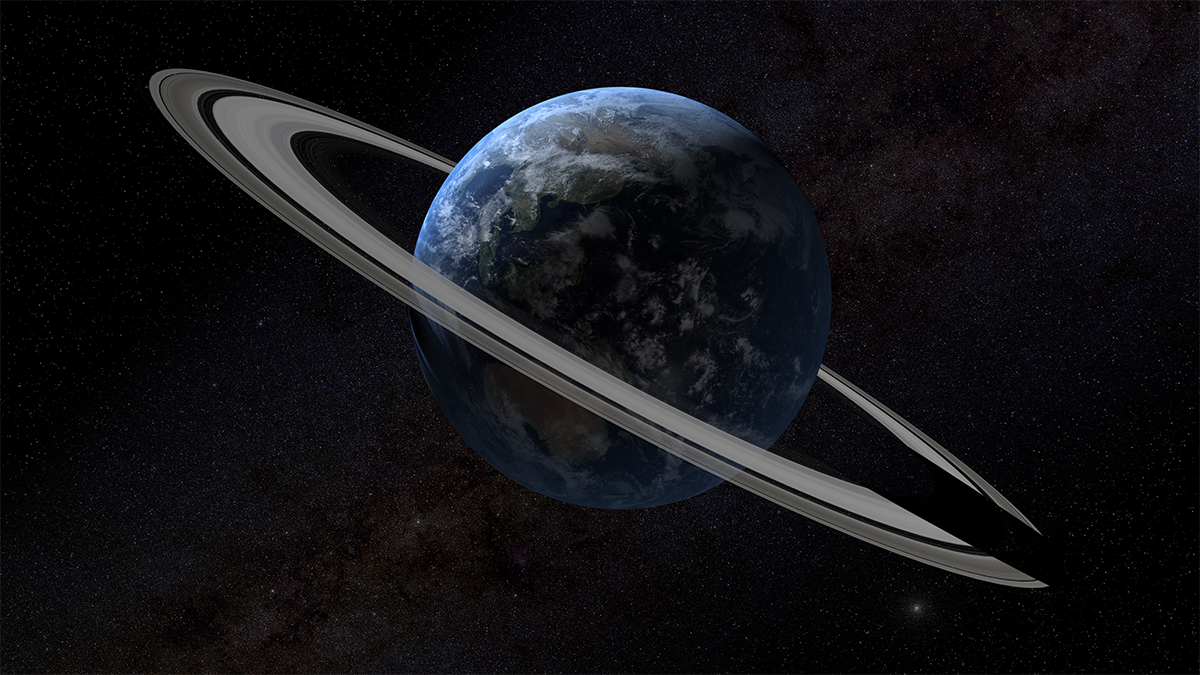The Earth Might Have Been a Ringed Planet Long Ago

Everyone who has ever seen Saturn through a telescope is astonished to see the system of rings that surround it. Those rings are rock and ice that span thousands of kilometers around the planet. They are the hallmark of Saturn, but ring systems exist around Jupiter, Uranus and Neptune as well, albeit in less dramatic forms.
Yet, you shouldn’t need to be a giant planet to have a ring. As long as debris accumulates in the gravitational well of a planet, the rotation will cause it to form a ring a debris near its equator. How you build that ring can come in many forms, but one method would be for an asteroid to get a little too close and get caught by the planet … and then crushed by the tidal forces it feels thanks to the planets’s gravity.
Earth’s Ring?
A compilation of impact dates, tsunami deposits (megabreccia), L chondrite sediment and global temperatures that are cited as evidence for an Ordovidian ring and impacts. Credit: Tomkins and others (2024)
A new research paper by Andrew Tomkins and others in the journal Earth & Planetary Sciences makes the bold claim that Earth may have had a ring system in its past. Looking at the locations of crater, evidence in the sediment of oceans and some interesting climate coincidences, they say that starting around ~465 million years ago and lasting for 20-40 million years, a ring made from a destroyed asteroid graced the skies of our planet.
Tomkins and his colleagues were intrigued by a window of time in the Ordovician period (~485-443 million years ago) where the rate of impacts seem to be higher on Earth based on the evidence of preserved craters. Combine that with a sharp increased in material that is derived from a certain type of asteroid, it was clear that the Earth was getting more debris from space.
One hypothesis is that maybe something happened in the asteroid belt sending smaller chunks of rock towards the inner solar system. This could explain why there are more craters and this increase in asteroid-derived material in sediment (2-3x more than normal), but there was no evidence of more impacts of this age on Mars or the Moon. Why only Earth?
What Tomkins and his colleagues reasoned was that if the asteroid-derived material was all the same (L chrondrite to be specific), then it makes sense that maybe only one object was the source. Maybe it was from an asteroid that strayed too close to Earth?
Death of an Asteroid, Birth of a Ring
The reconstructed locations of impacts during the Ordovician Period. These impacts are suggested to be from a disintegrated asteroid that passed too close to Earth. Credit: Tomkins and others (2024).
They rebuilt the world map at the time using plate tectonic reconstructions and found that the major impacts preserved (at least 21!) from the period fall within a band that is unlikely to be random. Instead, they would make sense as a series of large impacts from some body that got crushed as it passed too close to our planet.
Instead of a single, massive impact, the asteroid rained down on Earth as smaller pieces. After the asteroid was destroyed near Earth, it formed a nascent ring around our planet. Then, over 40 million years, as all the debris fell from orbit. The L chondrite material in the world’s sediments remained elevated as all this stuff landed on the planet, but then returned to normal once the ring was erased.
There is also evidence in the rock record that this period was marked by many large tsunamis and earthquakes. This could be explained by numerous asteroid impacts across this 40 million years that generated massive waves that piled debris on the shores of the supercontinent and smaller landmasses that existed at the time.
Climate Questions Solved?
This theory presented by Tomkins and his colleagues of a terrestrial ring could answer some vexing questions. During this time period, the Earth’s climate cooled but carbon dioxide stayed high in the atmosphere. As we know from current climate change, carbon dioxide should make things warmer, but if a ring was shading part of the Earth and reflecting sunlight, the climate would cool. Add the dust in the air from the material raining out over millions of years, the combined impact could be 8C of cooling.
The climate record also suggests the Earth got warm again around 440 million years ago, which according to Tomkins and colleagues’ ring theory, coincides with when the ring would have like dissipated. There may have even been some small moons that formed that were destroyed as well over this window.
It is fascinating to think about what a ringed Earth might have looked like from the ground. Sadly, not much lived on the Earth’s surface other than some of the earliest land plants. The animals of Earth all lived in the vast oceans that covered much of the planet at the time. Yet, a ring stretching off into the cosmos would have made for a very different planet than we have today.
